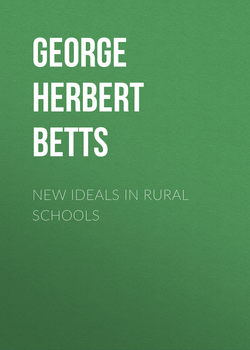Читать книгу New Ideals in Rural Schools - George Herbert Betts - Страница 6
II
THE SOCIAL ORGANIZATION OF THE RURAL SCHOOL
ОглавлениеEvery school possesses two types of organization: (1) an intellectual organization involving the selection and arrangement of a curriculum, and its presentation through instruction; and (2) a social organization involving, on the one hand, the inter-relations of the school and the community, and on the other the relations of the pupils with each other and the teacher.
The rural school and the community
The rural school and community are not at present in vital touch with each other. The community is not getting enough from the school toward making life larger, happier, and more efficient; it is not giving enough to the school either in helpful coöperation or financial support.
In general, it must be said that most of our rural people, the patrons of the rural school, have not yet conceived education broadly. They think of the school as having fulfilled its function when it has supplied the simplest rudiments of reading, writing, and number. And, naturally enough, the rural school has conceived its function in the same narrow light; for it is controlled very completely by its patrons, and a stream cannot rise higher than its source.
Because of its isolation, the pressing insistence of its toil, and the monotony of its environment, the rural community is in constant danger of intellectual and social stagnation. It has far more need that its school shall be a stimulating, organizing, socializing force than has the town or city. For the city has a dozen social centres entirely outside the school: its public parks, theatres, clubs, churches, and streets, even, serve to stimulate, entertain, and educate. But the rural community is wanting in all these social forces; it is lacking in both intellectual and social stimulus and variety.
One of the most pressing needs of country districts is a common neighborhood center for both young and old, which shall stand as an organizing, welding, vitalizing force, uniting the community on a basis of common interests and activities. For while, as we have seen, the rural population as a whole are markedly homogeneous, there is after all but little of common acquaintanceship and mingling among them. Thousands of rural families live lives of almost complete social isolation and lack of contact with neighbors.
This condition is one of the gravest drawbacks to farm life. The social impulse and the natural desire for recreation and amusement are as strong in country boys and girls as in their city cousins, yet the country offers young people few opportunities for satisfying these impulses and desires. The normal social tendencies of youth are altogether too strong to be crushed out by repression; they are too valuable to be neglected; and they are too dangerous to be left to take their own course wholly unguided. The rural community can never hope to hold its boys and girls permanently to the life of the farm until it has recognized the necessity for providing for the expression and development of the spontaneous social impulses of youth.
Furthermore, the social monotony and lack of variety of the rural community is a grave moral danger to its young people. It is a common impression that the great city is strewn thick with snares and pitfalls threatening to morals, but that the country is free from such temptations. The public dance halls and cheap theaters of the city are beyond doubt a great and constant menace to youthful ideals and purity. But the country, going to the opposite extreme, with its almost utter lack of recreation and amusement places, offers temptations no less insidious and fatal.
The great difficulty at this point is that young people in rural communities are thrown together almost wholly in isolated pairs instead of in social groups; and that there are no objective resources of amusement or entertainment to claim their interest and attention away from themselves. They are freed from all chaperonage and the restraints of the conventions obtaining in social groups at the very time in their lives when these are most needed as steadying and controlling forces. The result is that the country districts, which ought to be of all places in the world the freest from temptation and peril to the morals of our young people, are really more dangerous than the cities. The sequel is found in the fact that a larger proportion of country girls than of city girls go astray. Nor is the rural community more successful in the morals of its boys than its girls. In other words, the lack of opportunities for free and normal social experience, the consequent ignorance of social conventions, and the absence of healthful amusement and recreation, make the rural community a most unsafe place in which to rear a family.
